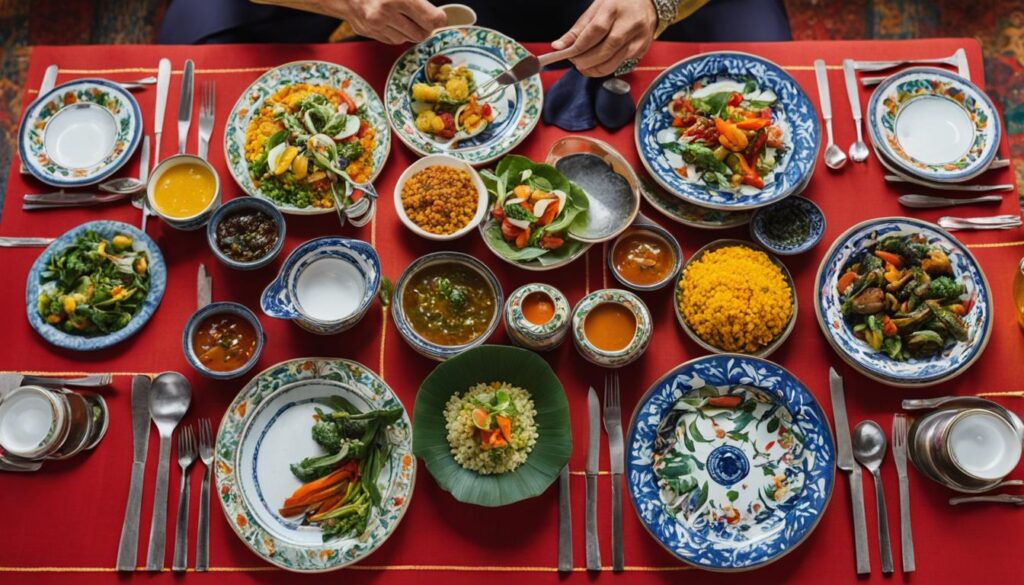What are some essential cultural norms to know before traveling? Understanding travel customs and global etiquette is essential for any traveler wishing to have a positive and respectful travel experience. When traveling, you will interact with people from different cultures and backgrounds, and understanding cultural norms is critical to avoiding cultural misunderstandings and promoting cultural sensitivity.
Whether you are traveling for business, leisure, or educational purposes, cultural norms play a significant role in shaping your travel experience. From dress code customs to dining etiquette, communication styles to gift-giving traditions, knowing how to navigate cultural norms is key to having a memorable and enjoyable trip.
In this article, you will learn about the significance of cultural norms when traveling, and how to be culturally sensitive while respecting international customs. We will delve into the dos and don’ts of cultural etiquette, dress code customs around the world, and greetings and gestures that vary across different cultures. You will also learn about dining etiquette, language considerations, respect for sacred sites and customs, and how to navigate social events and celebrations in different cultural contexts.
By the end of this article, you will be equipped with essential cultural knowledge that will help you navigate the unfamiliar terrain of a new destination and interact respectfully with locals, promoting cultural understanding and tolerance.
Why Cultural Norms Matter When Traveling
When traveling, it’s not only about seeing beautiful sights or trying exotic foods. It’s also about respecting the culture and customs of the destination country. Cultural norms play a significant role in shaping the behavior and attitudes of locals, and understanding them is crucial for building respectful and meaningful relationships.
Cultural sensitivity is essential when traveling. It means showing respect and consideration for the beliefs, practices, and traditions of others. By embracing cultural diversity and understanding the cultural norms of the destination country, you not only show respect and tolerance but also avoid accidentally causing offense or misunderstandings.
For instance, cultural norms impact how people greet each other, what they wear, and how they behave in public spaces. In some cultures, it’s customary to bow instead of shaking hands, while in others, it’s considered inappropriate to show physical affection in public. By being aware of these cultural differences, you can avoid offending locals and show that you’re interested in learning about their customs and traditions.
Overall, cultural norms matter when traveling because they shape the behavior, values, and attitudes of locals. Being culturally sensitive and understanding the customs and traditions of the destination country is essential for building respectful and meaningful relationships. By embracing cultural diversity and following the local norms, you can make the most of your travel experience and create lasting memories.
Cultural Etiquette Dos and Don’ts
When traveling to a foreign country, it’s important to respect and adhere to the cultural norms and social customs of the locals. Here are some dos and don’ts to keep in mind:
Do:
- Research the country’s cultural etiquette before you go
- Learn some basic phrases in the local language to show respect
- Dress modestly in conservative countries
- Remove your shoes before entering a house or temple in many Asian and Middle Eastern countries
- Use your right hand for eating and shaking hands in many countries, as the left hand is considered unclean
- Be punctual for appointments in Western countries, but expect a more relaxed sense of time in many other parts of the world
Don’t:
- Assume that your way of life is better or more superior than the local culture
- Show excessive displays of public affection in conservative countries
- Wear revealing clothing in conservative countries
- Point with your finger, as it is considered impolite in some Asian and Middle Eastern countries
- Disrespect religious customs and traditions
- Become impatient or demanding with slow service in some countries where the pace of life is slower
| Cultural Norm | Do | Don’t |
|---|---|---|
| Dress Code | Dress modestly in conservative countries. | Wear revealing clothing in conservative countries. |
| Table Manners | Use your right hand for eating and shaking hands in many countries, as the left hand is considered unclean. | Eat with your left hand in many countries. |
| Religious Traditions | Respect religious customs and traditions. | Disrespect religious customs and traditions. |
| Punctuality | Be punctual for appointments in Western countries, but expect a more relaxed sense of time in many other parts of the world. | Become impatient or demanding with slow service in some countries where the pace of life is slower. |
Remember, showing respect for cultural norms and social customs can lead to a more positive and enjoyable travel experience. By following these dos and don’ts, you can ensure you’re being a respectful and culturally sensitive traveler.
Dress Code Customs Around the World
When traveling to a foreign country, it’s important to consider dress code customs to show cultural respect. In some cultures, dressing modestly is highly valued, while others prioritize formal attire for special events. To ensure that you’re dressed appropriately, consider the occasion and destination, and research cultural norms ahead of time.
| Country | Occasion | Dress Code |
|---|---|---|
| Japan | Business Meeting | Formal Attire (Dark Suit) |
| Middle East | Mosque Visit | Modest Attire (Long Sleeves, Cover Hair and Legs) |
| Hawaii | Luau | Casual Attire (Shorts, Hawaiian Shirt) |
| India | Wedding | Traditional Attire (Sari, Kurta) |
It’s also important to note that some countries have strict laws regarding dress code. For example, in some Islamic countries, women are required to cover their entire body in public. In Thailand, it’s illegal to leave your house without wearing underwear. Be sure to research the laws and customs of your destination to avoid any legal issues or cultural misunderstandings.
Remember, dressing appropriately also shows respect for the local culture and can help you to better integrate with the society. Additionally, it can also be an opportunity to embrace the cultural traditions and express your admiration for them.
Greetings and Gestures: How to Say Hello Around the World
Understanding greetings and gestures is a fundamental aspect of cultural norms when traveling. In some cultures, it is customary to greet someone with a handshake, while in others, a bow or a kiss on the cheek is more appropriate. Each country has unique traditions that reflect their cultural values and history.
For instance, in Japan, people often bow to show respect and gratitude. The depth of the bow typically depends on the relationship between the people involved, with a deeper bow signifying deeper respect. Meanwhile, in India, people greet each other with a Namaste, a gesture that involves pressing the palms together and slightly bowing the head. The word Namaste translates to “I bow to the divine in you,” emphasizing the spiritual aspect of the greeting.
It is essential to understand the cultural context behind these gestures to avoid any unintentional offense. In some cultures, eye contact during a greeting is considered disrespectful or aggressive. Similarly, a smile may not always be an appropriate response, as in some cultures, it could be perceived as insincere or inappropriate.
Avoid making assumptions about the appropriate greeting or gesture when traveling to a new country. Research the cultural norms before you arrive, and observe local behavior to gain a better understanding of the cultural context. By showing a willingness to engage and understand cultural differences, you can build positive relationships with locals and have a more enriching travel experience.
Dining Etiquette: How to Navigate Food Customs Abroad
When traveling abroad, it’s important to be mindful of dining etiquette and cultural norms surrounding food. To avoid offending your hosts or fellow diners, it’s essential to familiarize yourself with the local customs and follow their lead. Here are some tips to help you navigate dining etiquette abroad:
Table Manners
Table manners vary widely across cultures, so it’s important to observe local customs. In some countries, slurping or burping is a sign of enjoyment, while in others it’s considered impolite. Similarly, using your hands to eat may be perfectly acceptable in some cultures, while in others it’s considered rude. It’s best to follow the lead of those around you and avoid doing anything that might offend your hosts or fellow diners.
Tipping Practices
Tipping practices also vary widely across cultures. In some countries, like the United States, tipping is expected and failure to leave a tip may be seen as a sign of disrespect. In other countries, like Japan, tipping is not customary and may even be viewed as an insult. Before you travel, research tipping practices in your destination country to avoid any cultural missteps. If in doubt, ask a local for guidance.
Trying Local Cuisine
When dining abroad, it’s important to be open to trying local cuisine. Not only is it a delicious way to immerse yourself in the local culture, but it also shows respect for your hosts and their culinary traditions. Be adventurous and willing to try new things, but also be mindful of any dietary restrictions or allergies.
| Country | Dining Custom |
|---|---|
| Japan | Slurping noodles is a sign of enjoyment. |
| Italy | It’s polite to leave a little food on your plate to show that you are satisfied. |
| China | Burping after a meal is a sign of satisfaction. |
Remember, dining etiquette is an important aspect of cultural norms and global etiquette. By observing local customs, trying new foods, and being respectful of your hosts and fellow diners, you can ensure a positive and enjoyable dining experience.
Gift-Giving Traditions: Customs and Etiquette
Gift-giving is an essential aspect of many cultures, often serving as a symbol of gratitude, respect, or friendship. However, appropriate gifts and customs vary widely across the world, and it’s crucial to understand cultural norms to avoid causing offense. Here are some insights into the gift-giving traditions and etiquette for some of the most popular travel destinations:
| Country | Appropriate Gifts | Gift-Giving Customs |
|---|---|---|
| Japan | High-quality chocolates, tea sets, or traditional handicrafts | Wrap your gift neatly and always offer it with two hands. Avoid gifting in sets of four, as this number has negative connotations. |
| Mexico | Handmade pottery or ceramics, local textiles or clothing items | Gifts are usually opened immediately, so don’t be offended if the host unwraps your gift right away. Avoid giving sharp objects or anything with dark colors. |
| India | Sweets, fruits, or small souvenirs from your home country | Offer your gift with your right hand, or both hands if it’s large. If you receive a gift, it’s polite to open it in front of the giver. |
Remember that reciprocity is essential in gift-giving, and it’s courteous to give a thoughtful gift in return if you receive one. Additionally, it’s essential to be culturally sensitive when offering gifts, especially when it comes to religious or traditional customs. Avoid wrapping gifts in white, as it’s often associated with mourning in many cultures.
By understanding and respecting cultural norms related to gift-giving, you can form more meaningful connections with locals and show your appreciation for their hospitality.
Communication Styles and Language Considerations
When traveling to a foreign country, it is crucial to understand the local communication styles and language considerations. Cultural norms play a significant role in how people communicate, and failure to adapt to these differences can lead to misunderstandings and miscommunications.
Language considerations are also essential when traveling. While English may be widely spoken, it is respectful to learn a few basic phrases in the local language to show cultural sensitivity and appreciation for the host country’s culture. Remember that speaking louder or slower in English does not necessarily help overcome language barriers. Instead, nonverbal cues like facial expressions, gestures, and tone of voice can also affect communication and understanding.
Here are some tips for navigating different communication styles and language considerations:
- Be patient and listen actively to the local people you interact with. This demonstrates respect and willingness to learn while building a positive relationship.
- Watch for nonverbal cues and adapt accordingly. For example, in some cultures, avoiding direct eye contact is a sign of respect and deference.
- Use simple, straightforward language and avoid complex sentence structures or slang. This helps to ensure clear understanding on both sides.
- Consider the tone and formality of communication. In some cultures, it is common to use formal titles and honorifics when addressing someone in a professional setting.
By understanding communication styles and language considerations, you can successfully navigate cultural differences and build meaningful connections with locals. Remember that respect for cultural norms is a cornerstone of a positive travel experience.
Respect for Sacred Sites and Customs
When traveling to different parts of the world, it’s important to respect sacred sites and customs. It shows that you understand and appreciate the unique cultural norms of the destination and promotes greater understanding and tolerance.
One common thread among many cultures is the reverence for religious or spiritual sites. Whether it’s a temple, mosque, church, or shrine, these places hold a special significance to the local community and should be treated with care and respect.
When visiting sacred sites, be sure to dress appropriately. This generally means covering your shoulders and legs, and removing your shoes before entering. Some cultures may also require head coverings or modest clothing, so it’s always a good idea to research local customs before you go.
Remember that these sites are not tourist attractions, but rather places of worship or contemplation. It’s important to keep noise levels down, avoid flash photography, and follow any posted rules or guidance from local authorities.
In addition to religious sites, there may also be customs and traditions related to natural landmarks or historic sites. For example, in many Indigenous cultures, certain natural sites are considered sacred and should not be disturbed or photographed without permission.
By respecting sacred sites and customs, you demonstrate your commitment to cultural sensitivity and global etiquette. This can lead to more meaningful interactions with locals and a deeper appreciation for the diverse world we live in.
Navigating Social Events and Celebrations
Social events and celebrations are an excellent way to experience the rich diversity of cultural norms around the world. Understanding cultural traditions related to celebrations can allow you to participate more fully in local events, building relationships with locals and gaining an appreciation for their culture.
When attending social events or celebrations, it’s essential to be aware of the customs and norms specific to that culture. For example, in some cultures, it’s customary to remove your shoes before entering someone’s home. In others, it may be appropriate to bring a gift to the host. These small gestures can go a long way in showing respect and building connections.
It’s also essential to be respectful of local religious and cultural customs. For example, if attending a religious ceremony, dress modestly and follow any specific rules related to attire or behavior. If attending a cultural festival or event, be mindful of any traditional music, dance, or costumes, and participate with respect.
Finally, try to learn some basic phrases in the local language to communicate with locals. This small effort can go a long way in showing your interest in their culture and building connections.
In summary, participating in social events and celebrations can be an excellent way to experience local culture when traveling. By understanding and respecting cultural norms related to celebrations, you can build meaningful connections and gain a deeper appreciation for the diversity of our world.
Conclusion
Understanding and respecting cultural norms is essential for a positive and respectful travel experience. By embracing cultural diversity and engaging in respectful interactions, you can contribute to fostering cultural understanding and tolerance.
Throughout your travels, it is important to recognize the impact of cultural norms on interactions with locals, and to be culturally sensitive. This involves learning about customs and traditions, adapting to different communication styles, and being mindful of appropriate behavior in different social contexts.
By navigating cultural norms with respect and openness, you can enhance your travel experience while also promoting cross-cultural understanding. Keep in mind that every culture is unique, and that cultural norms may vary widely from one destination to another.
We hope this guide has provided you with valuable insights into cultural norms and their importance when traveling. Remember to approach your travels with an open mind and a willingness to learn about and respect different cultures. By doing so, you can embark on a journey of respectful travel that is both enriching and rewarding.

















































